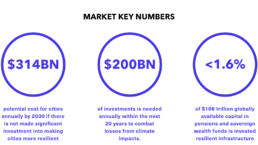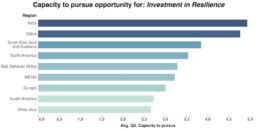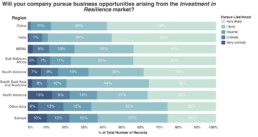Institutional investors can play an instrumental role in protecting societies against extreme weather by channeling assets towards resilience-building initiatives and infrastructure.
Today, institutional investors in OECD countries alone manage assets worth almost USD 80 trillion. If just a fraction of this volume of capital is directed towards investments in infrastructure resilient to extreme weather, both societies and investors will benefit. Local and national governments will be able to mobilize the vast capital investments required to protect cities and infrastructure from increasingly frequent extreme weather events. At the same time, institutional investors will be able to invest in asset classes with a steady long-term income stream. These assets also have a low association with other asset classes, thus lowering investors’ overall risk profile. Investors are also becoming increasingly interested in using the environmental, social and corporate governance profile of companies as a measure by which to evaluate their attractiveness.

The World Bank estimates that just one percent of the assets managed by pension funds today are invested in infrastructure, but it sees great potential to increase this figure. The size of the climate-related bond market has almost tripled since 2005, illustrating that these asset classes are becoming more attractive to investors. However, governments and markets alike can take further action to help mobilize private sector capital for infrastructure resilient to extreme weather. To achieve this, governments can create clear and predictable policy frameworks combined with a transparent pipeline of investable projects.
Public-private partnerships or other innovative joint financing schemes can be used to create attractive investment opportunities with low risk for private investors. For their part, investors can upgrade their capacity to understand and predict the special challenges and risks associated with these investments.
Survey Findings
There is a close link between the market opportunity Investments in Resilience and public-private partnerships and other forms of public-private co-financing. As such, the survey results from both the governmental and finance sectors are of special interest. However, respondents from these sectors express a less favorable reception of this market opportunity when assessed for its potential benefits for society.

In Europe and Sub-Saharan Africa it does get the best assessment of the three market opportunities related to the risk of extreme weather surveyed in 2014. However the skepticism towards it is still strong even in these regions. When asked when this opportunity will reach its full potential, one third of all respondents in Europe believe this opportunity “will never happen”.

Respondents in the finance and service sectors are the most positive in comparison to other sectors when looking at its benefits to their businesses.
This market was surveyed globally in 2014 by more than 5500 leaders from both the public and private sectors. The survey was conducted in collaboration with the research company YouGov. The survey results were originally published in the Global Opportunity Report 2015.

